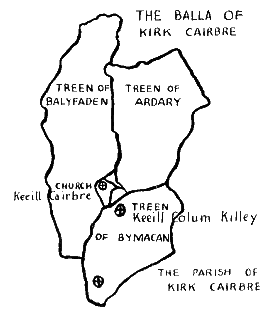
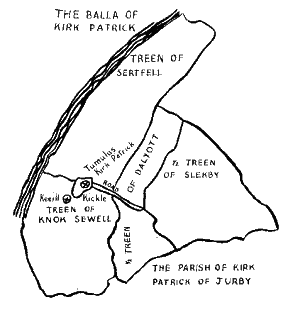
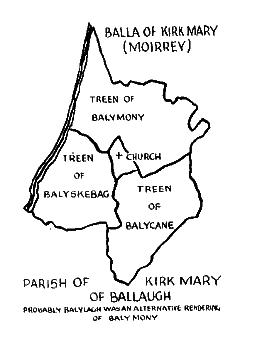
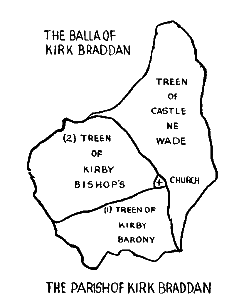
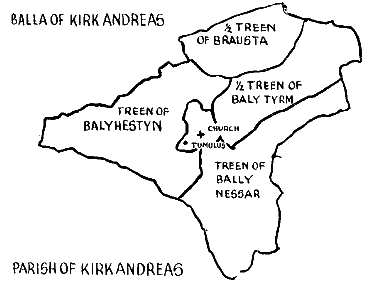
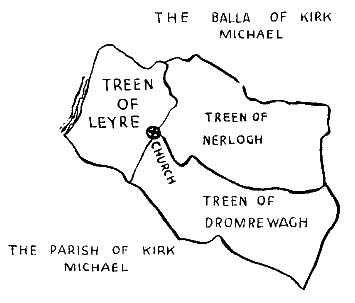
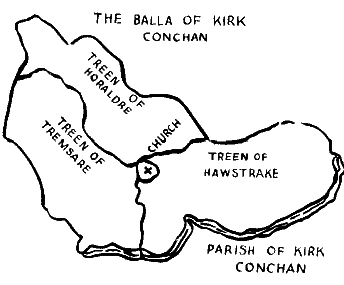
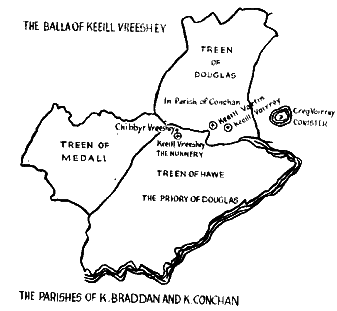
[from Proc IoMNH&ASoc vol 4 #2 1936]
[Note this reflects the then thoughts about the Norse - the Inis Patrick is now no longer thought to be the Manx Patrick's Isle - modern thinking tends to place the main Norse control of Island somewhat later and mediated via Dublin]
At a meeting of the Society held at Clifton House on 19th December, 1936, Mr J. J. Kneen, M.A., read the following paper.
If I were to ask anyone present, what was the Golden Age of Manx history, I expect most of you would reply, "The Norse Period." Well, I am not going to dispute that point, although those of you who have broused in "The Chronicle of Mann and the Isles," may have closed the volume with mixed feelings. I am going to attempt, in this paper, to lift the curtain which the Norsemen rang down over a thousand years ago. Let us lift it a few inches and peer into the Celtic gloom.
Just as rocks show the foot-prints of animals which roamed the earth millions of years before man appeared, so there are certain words in the Manx language which have come down to us from those Celtic sires which the Norsemen subjugated, but never really conquered.
Even if we had not a shred of historic evidence beyond our keeills. the foundations of these tiny churches remain as mute memorials of a time when Mann was a centre of Christian culture and abiding peace. The Norsemen had no part in the building of these. The coming of the Norsemen heralded the total annihilation of everything that appertained to the peace and welfare of the Manx Gaels, and it was not until several centuries had passed away that the warlike spirit of the Norsemen was softened by the infusion of Gaelic blood. Although the Norsemen eventually became Christians; when they landed on our shores they were animated by the spirit of destruction rather than that of construction. In A.D. 798 they burnt Inis Patrick-Peel Island-and bore away the shrine of Dochonna. At that time there was probably a small monastic community on Inis Patrick, and it is impossible to estimate how many holy men were slain on this occasion. Even as early as A.D. 616 we read of the burning of Eigg in the Hebrides, and the massacre of 150 martyrs. These are but samples of a succession of barbarities carried on for about two centuries by the Norsemen, whose warrior instincts were fortified by conflict of religious ideals.
Whatever literature existed in Mann before the Norsemen came has disappeared for ever. We find the ancient literature of Ireland scattered about in monasteries of Europe. In A.D. 849 we read Innrechtach, Abbot of Iona, came to Ireland with the reliques of Saint Columba. What remained of the precious library was scattered; the result being that the earliest document of Scottish history, Adamnan's " Life of Coluincille," is now at Schaffhausen, and the art treasure of the West, the Book of Kells. emanating ultimately from the chief centre of Columba's activity, lies now in Trinity College, Dublin. It was absolutely necessary to carry them to other lands, otherwise alike the glory they confer on their authors and on their country, as well as the unique light shed on the story of civilisation would have vanished into the darkness for ever. Even the shrine wherein Columba's bones rested was coveted, and for refusing to disclose its hiding place, Blathmac was cruelly put to death, A.D. 825.
An old Gaelic couplet written on the margin of a copy of Priscian's Latin Grammar, now in Saint Gall, Switzerland, is supposed to have been written in the first half of the 9th century, and brought by wandering Irishmen to the Continent. From notes on the margin it has been concluded that the M.S. was written either in the year A.D. 845 or 856. The lines referred to must have been penned by one who had known well of the coming of the Norse, and in all likelihood in Ireland, or mayhap in Mann, where on a certain wild night his feeling of relief found expression thus:
Is acher ingaith innocht fufuasna fairge findfolt
Ni agor réimm mora minn. dond taechraid lainn na lothlind.i.e. Bitter is the wind tonight: it tosses the ocean's whitehair;
I fear not the coursing of a clear sea by the fierce heroes of Norway.
The poetry of Celt and Norseman reflect the characteristics of the individual races. The Celt sings of the blossoming of trees in Springtime, the call of the cuckoo, the song of the lark; whilst the Norseman sings of the blood-stained battlefield. the cry of the raven and the eagle hovering over the slain.
It was not until Celtic and Scandinavian blood mingled that the latter began to absorb more thoroughly the rites of the Celtic Church which in time embued the Norsemen with a new knowledge and culture and which eventually instilled in them those elements of beauty and tenderness which finally blotted out those warlike instincts which characterised their ancestors.
Such then is the story of our Norse ancestors as handed down to us by the holy men of the montasteries. Then what of our Celtic sires?
At Scarlett, near Castletown, we see the marks of animals which roamed the land when the world was young; we can see their forms distinctly defined in the imperishable rock. Although they have ceased to exist for such a vast period that our feeble minds cannot bridge the interval between them and now.
The early Celtic history of Mann, although not separated from us by such aeons of time, is at first sight non-existent. but there are at least two channels open to us for investigation:
(1) The early history of Ireland as handed down by the Irish chroniclers, and (2) The marks left behind by our own history in the rocks of time. At present I do not intend to deal with the early history of Ireland. which must have been almost identical with that of Mann. Earlier workers in the same field have already done useful work in this direction, although they have not exhausted the subject by any means. I intend to deal with evidence we find in our native language, a language which was vigorous enough to withstand the influence of the Norse and English tongues for over a thousand years, and has still a kick left in it. In this now neglected and almost forgotten speech we find certain words which help us, in some degree, to peer into the Celtic darkness and visualise the lives of the Manx Gaels, how they parcelled out the land and how they governed themselves.
The Manx Gael must have been always a complex problem to his Norse and English lords; since Scandinavian rule he has never governed himself, he allowed the Norsemen to obliterate his Celtic place-names and used the names which the former imposd upon him, but he stuck tenaciously to his own language, he borrowed few words from the language of his masters, and even retained the names of the Celtic land divisions and officials connected therewith bequeathed to him by his Celtic sires. And thus, at the beginning of our written Manx history, we only find one word of Norse origin appertaining to Manx governmen, the word "Tynwald," and even this was a place-name, and referred to the spot where the Court was held rather than the Court itself. In the Chronicle we find that "a convention of the people was held at a place called Tynwald," and it is almost certain that English influence has been responsible for the preservation of a word of which we are all justly proud.
That the Manx Gaels eventually absorbed the Norse element is proved by such hybrid names as Corkill, Corlett, etc., and it is probable that when Sir John Stanley became King of Mann at the beginning of the 15th century, the Norse element had entirely disappeared and the Gaelic language flourished as vigorously as it had done prior to the coming of the Norsemen.
The Norsemen were great sailors, and it is no doubt due to that leavening that the Manx sailors became famous as sea-farers. it was mostly maritime words that the Gael borrowed from the Norsemen. The bowe, the stack, the sker, the giau, and such like. But the names of our land divisions and the officials connected therewith were all Gaelic, until the Englishman came, when he translated some of them into the English of the day. Whatever legislative terms the Norsemen may have used had disappeared for ever. There is only one doubtful example, the Lockman, which may postulate the Norse Lagman or Logman, in other words, our present Deemster. We find that in Iceland a similar metamorphisis took place, the once powerful Lagman descended the social scale until he became a mere court functionary. On the other hand, however, as we also have a Gaelic form for the Lockman, the Guilley Glish, of similar meaning, it is possible that the "lock" referred to the "fetters" with which the coroner's henchman trussed up an unruly client.
It is somewhat remarkable that the Manxman clung to his own legislative terms through five centuries of English rule, and used them as long as the Manx language was spoken. But new officials introduced by the English, such as the Captain of the Parish, he had no Manx for, and made no attempt to translate them, but was content to use the English form.
The largest and most primitive divisons of Mann were the two districts, North and South, the mountain range from North Barrule to Cronk yn Iree Laa, making a natural and efficient boundary. The two Deemsters are still living witnesses of this primitive division. The Southern Division is still the more important, at it must have been in early times. Here dwelt the Ard-Ree, the chief king, or ruler, of the Island, as the Norse kings did later. The stronghold or dun of the Ard-Ree was probably on the site now occupied by Castle Rushen. In the Northern District lived the Ree, or king, a deputy to the ArdRee or Chief King. Or it is possible that the Southern ruler was called the Ree, and the Northern Kiannoort. The latter word means "The head man of a fortress or fortification," and it is probable that one of his duties was to look after the fortifications of the Island. In early Stanlevan times we find the Kiannoort anglicised Captain. We probably still find an echo of the old regime in the term Lieut.-Governor, i.e., a deputy to the King. In pre-Norse days the residence of the Kiannoort may have been on the site of Bishop's Court. It has been recorded that fortifications have been demolished there in the past.
Both the Rheynn Jiass, the Southern District, and the Rheynn Twoaie, the Northern District, had their chief Plan of the Law, the Gaels called trim the Briw, the Norsemen called him the Lagman. and the English called him the Deemster. Of these three words the latter alone survives, but it must be borne in mind that "Deemster" was never used when Manx was spoken, the Gaelic form Brie, lasted as long as the language itself.
The next division was the Sheading, a word I approach almost with fear and trembling. The Gael, Norseman and Saxon have each in turn claimed it, and I must confess my own guilt in claiming it as a Gaelic word. But during one of my lucid intervals, I arrived at the definite conclusion that it was neither Gaelic nor Norse, but purely English. I do not pretend to be the originator of this theory; I know I am not. But I am now fully convinced that "Sheading" is a Middle English word introduced by the Stanleys, or at some date between the end of Norse rule and the beginning of English rule. Then what word did it displace-was there a Gaelic or Norse word? As far as I can trace there was no Norse word, or if there was it disappeared with Norse rule. We find the Gaelic word happily preserved in the name Toshiagh-Joarey, now by translation, Coroner. Toshiagh-Joarey means the Chieftain of the Boundary or Division-the old Gaelic form being Toiseach-Teora. In Teora then, we have the old Gaelic name of the Sheading. Each Sheading or Teora had its Chieftain, and the latter must have been a person of some importance in pre-Norse days.
Another officer attached to the Sheading was the Meoir. The English did not translate this word, but borrowed it in the form Moar, and we may judge the importance of this individual from the fact that in Scotland, after English rule, the moars became barons, and the mor-moars, or great moars (or stewards) became earls. The office of Meoir is now extinct in the Isle of Man; from our earliest written records they simply collected the Lord's rents.
The remainder of the divisions we have to consider are the balla or townland, the treen or third, and the kerroo or quarterland. The word "treen" is somewhat on a par with "sheading," although a simple Gaelic word meaning "a third," no one would believe it, for the simple reason that all attempts to prove the unit of which it was a fraction produced negative results. I stumbled across the solution in a rather remarkable manner. When reading the old ballad of Manannan Mac Lir, I noticed the lines, "Ayns dagh treen balley ren eh unnane, da'n sleih sher ayn dy been y ghnee," i.e., "In each third of a balla (or townland) he made one (a church or keill) for the people therein to come and pray." The saint referred to was Carmane or German, as he was translated in English. Although I had read the ballad many a time, the significance of the phrase "treen balley" had hitherto escaped my notice, for here was the very clue I had been seeking for years. But a simple phrase in a ballad it not enough to base a theory on, it must be further substantiated, and this I was able to do by studying the positions of the treens. I then noticed that many of the parish churches were in the centre of a group of three treens. Here then was the solution, the three treens, or thirds, formed a balla, and these ballas, with a centre keeill, were chosen as the nuclei of the parishes somewhere in the early 13th century. Then what was the significance of the balla in pagan times? It the early Irish MSS ""balle" is glossed by the Latin "locus," a place; and this seems to have been its meaning at the dawn of history. Later, however, we find it not only prefixed to a treen, but also to a quarterland, and even much smaller pieces of land, such as intacks, etc. The pagan origin of the balla and treen is proved by the fact that the central church and cemetery is usually on a knoll or even on a fairly high hill, like Kirk Marown and Kirk Santon churches, and often there are other indications of a pagan nature, such as the tumulus in Jurby Churchyard. The centre of the balla, then, or the point where three treens met, was occupied by a pagan temple in pre-Christian times.
 |
 |
 |
 |
 |
 |
 |
 |
There were usually four quarterlands or kerroos in a treen, but they varied a great deal. I have already mentioned the name "Tynwald," let us consider it in all its aspects. For some reason the Manx Gaels did not use the name "Tynwald," and to the Manx language it was a stranger. In Manx the church was called Keeill Eoin, John's Church; the hill, Cronk Keeill Eoin, the hill of John's Church, and the fair, Margey Keeill Eoin, the fair of John's Church. Tynwald Day was Laa'l Eoin, the Day of John's feast. Even in our own time the fair was better known to us as Midsummer Fair than Tynwald Fair. This all goes to show that the very uniqueness of the name "Tynwald" has been the cause of its preservation. Like a beacon it shines along the way until it reaches the Celtic curtain, where its rays are dimmed into insignificance. But it is certain that the Norsemen did not originate the ceremonies which are still held at Tynwald. If one examines the surrounding land, signs of paganism are still traceable. Not far away are the remains of a megalithic monument which probably had a close connection with the Hill of Promulgations, the fair-ground is an extensive cemetery, and it is probable that the chapel occupies the site of an open-air temple. Tynwald Hill itself very likely marks the spot where one of our Island's early rulers was laid to rest. and it seems to be a small part of what at one time must have been an extensive monument.
The Norsemen, then, simply perpetuated a custom which had its roots deep in the past when they arrived. The same ceremonies existed in pagan Ireland before the dawn of history.
The dedication of the chapel and hill to S. John the Baptist, however, can only date from Christian times. In Ireland we find the Gaelic names of these old places of assembly preserved and the sites of many of them well known. The even flow of the history of Ireland has not been obliterated like ours, and the Norsemen left but little trace of their presence.
Is it possible for us to guess what the Gaelic name of S. John's or Tynwald Hill was before the coming of the Norsemen?
In the true Chronicle of Mann, the origin of which is obscure, it says in reference to the annual tribute to Manannan: " Some came with rushes to Wragfell and some to a place called Man, a place which is still so called." Wragfell of the tent is obviously an error for Wardfell, now Barrule. I shall deal with the other name, Mann, later.
In the ballad of Manannan Mac Lir we read:
" The rent which was coming to him (Mannannan) out of the country
Was a bundle of green rushes each year,
And it appears they were going with that
Throughout the country each John's Feast Eve.
Some of them were going up with it
To the top of that great mountain Barrule; Some others remained below
With Manannan above Keme-ool." (also Keamool).
Here we have two place-names, Mann and Keme-ool, obviously referring to the same neighbourhood. Can we still identify the place? I think we can, and with a certain amount of accuracy.
We can still see the traces of Manannan's tribute annually on Tynwald Day, in the green rushes with which the path from the chapel to the hill is strewn, and the old ballad definitely connects this ancient pagan god with Midsummer, or later, the Feast of S. John the Baptist.
Keim-ooyl (lr. Cérry Abaill) can only have one interpretation, "the Pass of the Apple Trees," a poetical name definitely pagan in origin, and probably referring to some old and long ago forgotten legend which we shall never now discover. This place was somewhere in the neighbourhood of Tynwald Hill, as was the name Mann, with which I shall now deal. Mann probably referred to Tynwald Hill itself, and is simply a worn-down form of its original name. But what could the latter have been? When we consider all the points it seems fairly clear that the pagan name of Tynwald Hill was Croc Manannaid, in modern Man Gaelic Cronk Vanannan, i.e., Manannan's Hill. The name Mann is therefore the first syllable of Manannan, and a worndown form of the old name.
The dedication of Tynwald Hill to a pagan deity does not necessarily imply that the hill could not have been the place of departure of an early Manx ruler.
Colloquially Mannannan was often called Adanaghan, and in several local names close to S. John's this name is incorporated.
A tumulus at Ballacraine is known as "The Grave of Managhan Beg," and this is clearly the name we have in. the old ballad where it states that " Manannan Beg was the son of Lir." Then we have Manannan or Managhan's Chair. in a. field called Managhan. In this field tradition says that Manannan or Managhan and the Devil had what is now popularly known as a "scrap." Which was the victor I cannot say, but as the legend is evidently an echo of the triumph of Christianity over paganism, it was probably his satanic majesty who won.
Then there is a road leading down to S. John's known as Bayr ny Managhan. which probably means Manannan's road, but there is also a legend here about the Monks using this road in travelling back and forward to the North to collect their tithes in kind, although the legend may have been a popular conception to explain a name which in Christian times would be regarded with a certain amount of suspicion, as having a smack of paganism.
The St. John's end of this road is-or was, known as the Follagh y Vannin Road. Now the latter name is obviously a corruption of Bollagh Vanannan, Manannan's Road, the English "road" being added when the meaning of the Manx had become obscure. This obviously old name rather discounts the legend of the monks, and it is quite clear that both names are simply variants, one part of the road being called Bollagh Vannannan and another part Bayr Vanannan. "Bollagh" and "bayr" are nearly identical in meaning.
The road leading from Knock Sharry to the Staarvey is called Bayr ny Hooyl, the Road of the Apples, or Apple Trees. Had this any connection with the name Keme Ooyl-the Pass of the Apple Trees-mentioned in the Manannan Ballad'
The following names are mentioned in an old Irish MS in connection with Manannan, and are generally thought to be in Mann: Emain Ablach and Cruitin na Cuan.
Emain, gen. Emna, having a Latinized form Emania, is another form of Mann.
Thus the name Emain Ablach is Old Irish for Mann of the Apple Trees." What is the significance of "apple-trees" in these names we cannot say, only that they are pagan in origin. Cruitin ny Cuan means the "little crook of the harbour." and may possibly have referred to Peel, as being the nearest port to St. John's.
The earliest piece of testimony extant with reference to the language spoken in Mann relates to the seventh century and establishes the conclusion that the language of Mann at that period was substantially identical with the Gaelic of Ireland. The evidence in cuestion is contained in a story r,elated in Cormac's glossary about a visit paid to the Island by Senchan Torpeist, who was the chief poet of Ireland from A.D. 649 to 662. Senchan, it is stated, was accompanied on this visit by fifty poets as his retinue, besides students. On their arrival on the Island, probably in the vicinity of Port St. Mary or Port Erin. the first person they saw was an old woman gathering seaweed. She asked them who they were, and after receiving their reply she gave them a couplet of verse and challenged them to cap it with a corresponding couplet. which one of their number did. Unfortunately neither of the couplets were recorded. for if they had been, they would have been of the greatest interest to modern students of Gaelic.
The old Manx name of the parish of Kirk German was Skyll Carmane. Whatever the latter word means, it certainly did not refer to any saint named German, and it is difficult to decide whether it referred to a personae or a territory.
The ancient Irish historians mention a place called Carman.. where there was a great fair held, called Oenach Carman. Irish authorities are divided as to the exact site of this fair, some claiming one county and some another. Could it have been in Mann on the place where Tynwald Fair is now held? It is a fascinating question. We certainly have the name in the parish, Skyll Carmane. Let us examine the facts as recorded in Irish history. Even the various descriptions of the place by different writers are conflicting, and it is possible that there may have been more than one place called Carman.
One account says that there was an Oinach held every three years-that is, a grand council of kings and chiefs-an exhibition. a cattle show, a fair and races. The site was an extensive cemetery with meeting mounds, raths, mounds, fields without houses reserved for the fair. A "cùan" (harbour) was there, with "ráth lind" (bounteous water), and "bruachib" (banks).
The harbour, bounteous water and banks might well apply to Peel. where merchants from Ireland and elsewhere would land to attend the fair.
The whole subject is of the greatest interest, and a closer examination if these ancient Gaelic records might throw a flood of light upon the pre-Norse history of Mann.
Perhaps some future Manx scholar will go into the subject thoroughly, for it is one deserving of investigation.
J.J.K.

|
|
|
|
|
||
|
Any comments, errors or omissions
gratefully received MNB
Editor HTML Transcription © F.Coakley , 2010 |
||